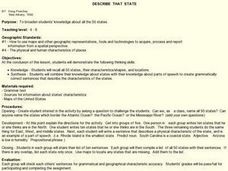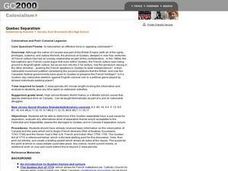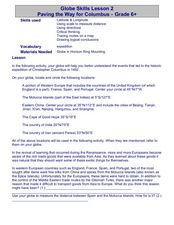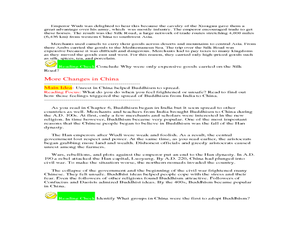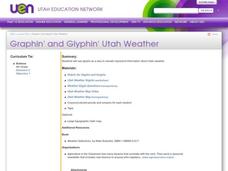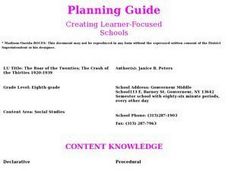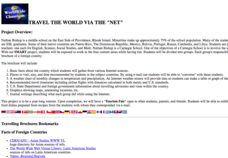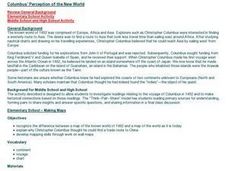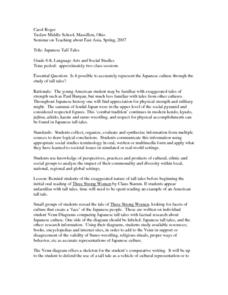Curated OER
Japanese Culture
Seventh graders make connections with the history of Japanese art with the modern use of ancient warriors in the popular Yu-Gi-Oh trading cards. They journal and reflect upon the research and comparison of the ancient to modern art.
Curated OER
Lesson Plan for Waiting to Waltz: A Childhood by Cynthia Rylant
Sixth graders examine the elements of writing poetry. In this creative writing lesson, 6th graders discuss a book of poetry in the setting of Appalachia. Students incorporate childhood experiences into the development of visual and...
Curated OER
Describe That State
Students broaden knowledge about all the 50 states. They combine their knowledge about states with their knowledge about parts of speech to create grammatically correct sentences that describe the characteristics of the states.
Curated OER
Smallville Prairie Development Project
Young scholars research the characteristics of the prairie habitat focusing on scientific, social/historical and aesthetic values. They investigate how humans impact the prairie habitat while maintaining a daily journal of research and...
Curated OER
Quebec Separatism
Students determine if the Quebec separatists have just cause for separation. They evaluate acceptable alternatives to separation. They assess damages to Quebec and Canada if separation occurs.
Curated OER
Globe Skills Lesson 2: Paving the Way for Columbus
Students explore the expedition of Christopher Columbus. In this geography skills lesson plan, students consider the technological advances that made Columbus's expedition possible as they complete a latitude and longitude activity.
Curated OER
Early China
Students journey back in time to early China. In this Chinese history lesson, students explore China's geography; read about the Shang, Zhou, and Han Dynasties; compare Confucianism and Daoism. Students create PowerPoint...
Curated OER
The Four P's of Marketing
Students explore how product, price, place and promotion play key roles in the marketing mix.
Curated OER
Graphin' and Glyphin' Utah Weather
Fourth graders use glyphs as a way to visually represent information about Utah weather. These nonverbal representations help students collect and interpret data in a visual format.
Curated OER
The Bread of the Sandwich
Students create relief maps of Canada and Mexico out of everyday objects like dried macaroni, dry rice, sand, etc. They create a clue card for a location game and try to stump their classmates. They host a travel fair to display their...
Curated OER
Where Am I?
High schoolers apply map reading skills by locating places through the use of latitude and longitude.
Curated OER
The Roar of the Twenties; The Crash of the Thirties
Eighth graders, after assuming identities of prominent figures from the 1920's and looking at slides and data from the era, relate, in diary form, the cultural, economic and political changes that happened in America between 1920 and 1939.
Project SMART
Travel the World Via the "Net"
Students work together to create a travel brochure of a foreign country of their choice. They use the Internet to research their information. They create graphics showing interesting locations. They write in their journals at the end of...
Curated OER
Contemporary Japanese Relief Printing
STudents identify and interpret relief printing and that the art of printing is not only an ancient art in Japan but a contemporary one as well. Students identify who Fumio Fujita is and his artworks.
Curated OER
Contemporary Korean Collage
Fourth graders engage in a lesson about Korean collages. They study an artist and the style in detail in order to become more acquainted to the art. Using this information the students create their own art in the same method and...
Curated OER
Lesson Plan on Korea
Students participate in a activity about ancient pottery making in Korea. The time of the research goes back to the 12th century. They read a story and study the attributes of characterization that the author uses.
Curated OER
Columbus' Perception of the New World
students investigate readings relating to the voyage of Columbus in 1492 and to make historical connections based on those readings. They form pairs to share insights and answer specific questions, and share information in a final class...
Curated OER
Read, Recognize & Graph Integers
Students explore negative and positive integers on a number line. They review a newspaper to determine careers that use positive and negative integers. In groups, they read and answer questions on "Lifestyles of the Rich and...
Curated OER
Is Coming to the United States of America Good for the Immigrant?
Student discuss whether coming to the United States was good for certain groups of immigrants. Using the internet, they examine settlement patterns for immigrants over a period of time. In groups, they role play the role of a family...
Curated OER
Fishing for El Nino
Learners explain why fish are in their usual location from the perspective of a worker on a fishing boat. They use clues clues, research, and a fake letter from their friend in North Carolina to determine the cause is El Nino.
Curated OER
Women's Involvement In The Progressive Era
Students participate in a lesson that is investigating the Progressive Era of history. They conduct research focusing on the role of women in era. The information provides the perspectives necessary to address the popular stereotypes...
Curated OER
Visit a Mesopotamian House
Students examine the various types of architecture used in Mesopotamia. In groups, they identify how climate, resources and cultures affect where and how people live. Using a worksheet, they compare and contrast their house to the one...
Curated OER
Japanese Tall Tales
Pupils read the tale of 'Three Strong Women' looking for facets of culture that create a 'face' of the Japanese people. They create a Venn Diagram comparing Japanese tall tales with factual research about Japanese culture. One side of...
Curated OER
Lessons in Loss, Year of Impossible Goodbyes
Students determine how the Korean people dealt with the loss of their land and traditional lifestyle in response to invasion and emigration. They create a list of items and people they have lost. From this they complete a journal...




